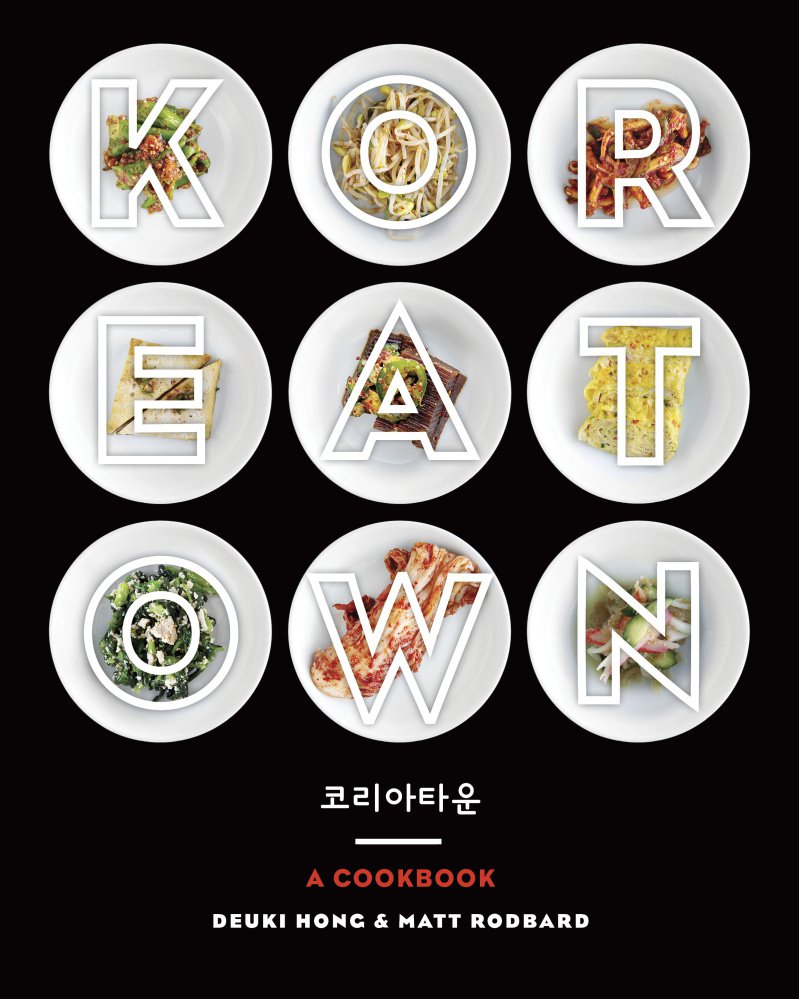“Koreatown: A Cookbook.” By Deuki Hong and Matt Rodbard. Clarkson Potter. $30.
In “Koreatown: A Cookbook,” chef Deuki Hong and food writer Matt Rodbard have created a book that seems to be many things at once without ever being too much: It is a food tour of some of the United States’ most vibrant Koreatowns. It is a cultural exploration of the influence of Korean food, including interviews with celebrity fans and notable chefs (Eric Ripert, chef and owner of Le Bernardin in New York, called the cuisine “the quintessential soul food from Asia”). It could even be seen not as a cookbook but as a guide to eating at Korean restaurants.
A two-page spread displays several rows of banchan, the small dishes of mostly fermented vegetables or braised meats that are arrayed on a table before a Korean meal, always without explanation. Each is labeled here. And many recipe notes contain advice that could come in handy the next time you find yourself in an H Mart food court: The best way to eat spicy kimchi stew, or jjigae, Hong and Rodbard explain, “is to pack a long-handled spoon with a little rice and dip into the bubbling pot. Eat. Smile. Repeat.”
For home cooks, there’s a comprehensive guide to essential Korean produce and pantry ingredients at the front of the book, plus a quick-reference glossary on the back cover, should you forget the difference between gochugaru (dried chile powder) and gochujang (fermented pepper paste). Also see the tip sheet called “How to Cook Korean Food at Home Without Pissing Off Your Neighbors.”
The quick-kimchi marinade, for fermenting fruits and vegetables in just a few hours or days, is worth memorizing. And if you have never tried kimchi pineapple, you should.
Throughout the book, the recipes include a delightful mix of the very traditional, such as Miyeokguk, a seaweed and beef soup long made to celebrate birthdays or to help new mothers regain their energy, and the less so. A chapter of guest recipes, from the writers’ chef friends who borrow often from “the Korean larder,” includes Kalbi Meatballs, and Coco-Cola and Gochujang-Marinated Chicken Thighs.
Hong, who recently left his post as chef of Kang Ho Dong Baekjeong in Manhattan to start a hospitality group, and Rodbard, a contributing editor at the online magazine Food Republic, explain in the book’s introduction that the photography is mostly documentary, portraying the dishes in actual Koreatown restaurants, as they are cooked there – not necessarily as the recipe describes.
So the image of kimchi fried rice, for example, appears to have slivers of seaweed mixed in, though there’s no seaweed in the ingredient list. The effect may be off-putting for cooks who need some hand-holding. But it makes the book feel lively and fits the message: Dig in – you’re gonna love it here.
— CHELSEA CONABOY

Serve kimchi fried rice from the pan or wok, topped with fried eggs, sliced scallions and gochujang butter. Sam Horine
OUR MILDLY INSANE KIMCHI BOKKEUMBAP (KIMCHI FRIED RICE)
Their recipe calls for homemade kimchi, the kind you forget in the back of the fridge until the smell of fermentation reminds you it’s there. I didn’t have any on hand and used some I bought in the store the same day. The dish was still delicious, though I’ll remember this recipe the next time I find myself with kimchi that’s so ripe it’s effervescent.
A word of advice: Don’t skip the gochujang butter.
1/2 pound of slab bacon, roughly chopped
1 medium onion, cut into small dice
2 garlic cloves, minced
1-inch knob of ginger, minced
11/2 cups chopped extra-aged kimchi
2 cups cooked rice, preferably day-old
1 tablespoon gochujang
2 tablespoons butter, softened
2 eggs, fried sunny-side up
2 scallions, sliced thin
In a large skillet, wok or cast-iron pan over high heat, cook the bacon, stirring, until fat is fully rendered and the bacon is barely starting to crisp. Pour out all but 2 tablespoons fat.
Add onion, garlic and ginger and saute for 1 minute, or until very aromatic. Add chopped kimchi and rice and saute, stirring frequently, for 4 to 5 minutes, or until very hot. Drop the heat to medium-low and flatten the rice with your spatula. Continue to cook until the bottom layer is crispy, about 2 minutes; think Spanish paella here. The longer you leave it, the more crispy the bottom will become, but be careful not to burn the garlic.
While the rice continues to crisp, in a small bowl mix together the gochujang and softened butter.
Serve from the pan or wok, topped with fried eggs, sliced scallions and gochujang butter.
Send questions/comments to the editors.



Comments are no longer available on this story